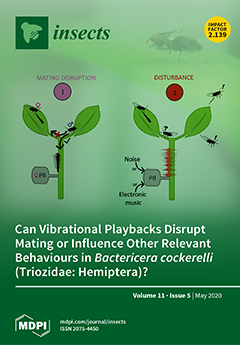The joint use of baculoviruses and synthetic insecticides for integrated pest management requires the study of the additive, synergistic or antagonistic effects among them on pest mortality. Droplet bioassays were conducted with
Autographa californica multiple nucleopolyhedrovirus (AcMNPV),
Spodoptera littoralis nucleopolyhedrovirus (SpliNPV) and seven
[...] Read more.
The joint use of baculoviruses and synthetic insecticides for integrated pest management requires the study of the additive, synergistic or antagonistic effects among them on pest mortality. Droplet bioassays were conducted with
Autographa californica multiple nucleopolyhedrovirus (AcMNPV),
Spodoptera littoralis nucleopolyhedrovirus (SpliNPV) and seven insecticides (azadirachtin,
Bacillus thuringiensis, cyantraniliprole, emamectin, metaflumizone, methoxyfenozide and spinetoram) on
Spodoptera exigua and
Spodoptera littoralis. The lethal concentrations LC
50 and LC
95 were calculated through probit regressions. Then, the sequential feeding of insecticides and nucleopolyhedroviruses was studied. Larvae were provided with the LC
50 of one insecticide, followed by the LC
50 of one nucleopolyhedrovirus 24 h later. The inverse order was also conducted. The insecticide LC
50 and LC
95 were higher for
S. littoralis than for
S. exigua. AcMNPV showed greater toxicity on
S. exigua than SpliNPV on
S. littoralis. Emamectin showed synergy with AcMNPV when the chemical was applied first, and metaflumizone and AcMNPV were synergistic regardless of the order of application, both from the first day of evaluation. SpliNPV was synergistic with azadirachtin and emamectin when it was applied first, but synergy was reached after 12–13 days. Excellent control is possible with the LC
50 of azadirachtin, emamectin and metaflumizone in combination with nucleopolyhedroviruses, and merits further study as a means of controlling lepidopteran pests.
Full article






